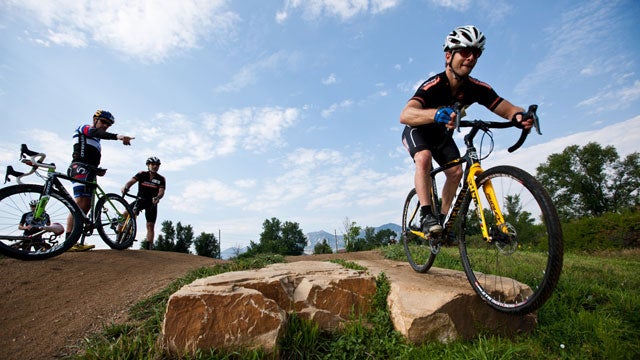As a middling Cat 4 road racer, but solid bike enthusiast, I’ve had a vague awareness of cyclocross for years. In my mind’s eye there were fluttering tape mazes across muddy fields (not unlike the fledging suburban developments I’d play in as a kid). There were cowbells and microbrews and beards. .��
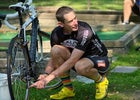 Coach Pete Webber teaches proper chain cleaning and lubbing at the Chicago Clinic
Coach Pete Webber teaches proper chain cleaning and lubbing at the Chicago Clinic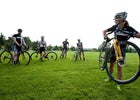 Beginning cyclocross riders learn how to carry the bike at a cyclocross clinic in Boulder, Colo.
Beginning cyclocross riders learn how to carry the bike at a cyclocross clinic in Boulder, Colo.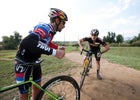 At a clinic in Boulder, Colorado, coach Tim Johnson (left) explains how the arms need to be used as shock absorbers.
At a clinic in Boulder, Colorado, coach Tim Johnson (left) explains how the arms need to be used as shock absorbers.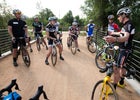 Coaches Pete Webber (far right) and Tim Johnson (second from right) dish the CX knowledge at a clinic at Boulder, Colorado’s Valmont Bike Park.
Coaches Pete Webber (far right) and Tim Johnson (second from right) dish the CX knowledge at a clinic at Boulder, Colorado’s Valmont Bike Park. Tim Johnson (VW jersey) discusses bunny-hop technique at a clinic in Chicago.
Tim Johnson (VW jersey) discusses bunny-hop technique at a clinic in Chicago.But as a New Yorker, cyclocross was something that always seemed to be happening elsewhere. Even relatively close-by Staten Island, (washed out last year by Hurricane Sandy), feels far away. Though my interest in the sport was growing, the chance of even finding a cyclocross race close to my home, much less actually competing in one, seemed impossibly distant. So when I heard that six-time national cyclocross champion Tim Johnson was putting on a in Boston, I saw my chance to dip my pedals in this foreign form.��
For the uninitiated, cyclocross (CX) is a curious blend of road cycling and mountain biking, invented in Europe more than a century ago as a way for road riders to keep fit during winter. Early ‘cross racers piloted single-speeds over courses that included boulder-strewn steeps and epic run-ups through sodden trenches. Modern courses vary, but tend toward loops on grass, with berms, sand traps, stairs, and other obstacles. Most notably, CX involves not only riding off-road, but hopping off the bike to clear barriers, storm mud-ravaged hillsides, and dance through crash-clogged turns.
According to USA Cycling, CX participation , to 100,000 riders racing last year. Perhaps because CX is inherently less painful since you crash on turf, not tarmac. And while races are competitive, there is a more low-key, inclusive vibe in ‘cross compared to the hermetic world of road racing. It’s also one helluva workout: Think Crossfit meets Tough Mudder. Cylcocross works various muscle groups in often less-than-ideal conditions, at sustained intensity. It’s been described as “an hour of hell.”
The welcome e-mail from the clinic’s organizer, Boulder-based cycling coach Pete Webber, posed the first dilemma: “It’s a good idea to do 1 or 2 dedicated ‘cross skills sessions before camp, to get your mojo working and your body used to the range of motion!”
Fine. But where? New York city parks didn’t even allow bikes on the grass. There were only a couple of options. Gathering my new CX setup—a bike with Crank Brothers “Candy” and Giro Privateer —I headed to , the city’s sole mountain-bike trail network, located (improbably) in Queens. In this leafy netherworld, I tensed up a bit when a pack of teens—harder-edged than the Goonies—came careening past on BMX bikes. And I nearly blindsided a couple on foot whose purpose in the park was decidedly not blazing single-track.��
For my second foray, a CX-savvy friend and I headed to , the one place in NYC where cyclocross seems to be tolerated, probably because there’s not much else out there besides an old psychiatric hospital and a waste-treatment plant. Nestled between the shit and the sanitarium, I hoisted my bike on my shoulder and struggled up short hills.
When I arrived in Boston, to a small, tented enclave in , there were about 30 attendees there, mostly men, rannging in age from teens to middle-age dudes like me. I made sure to assign myself to the beginner group. Cyclocross requires a rethink on various levels for the road racer. The first thing Johnson did when he saw me was grab my tires, wince, and release a blast of air pressure. In cross, we were told, the maximum PSI you should use is the minimum that the manufacturer labels on the tire. Cross tires are knobby, with directional tread, and Johnson pointed out that a few of my fellow noobs had put theirs on backwards.
We got right into it, with Webber and Johnson introducing us to the “attack position.” In cyclocross, where bike handling is more important than aerodynamics, the elbows should be bent and out, hands resting gently on the hoods, two fingers brushing the brakes. The legs, too, should be bent slightly and even bowed (the “cowboy position”), your butt just above the saddle, crank arms parallel to the ground. We were urged to turn our bodies into shock absorbers. “Feet heavy, hands light,” Webber told us as we took turns riding up and off a ramped one-foot plywood box.
Next was that primal cyclocross skill: dismounting and remounting. Pro Josh Anthony demonstrated this—riding full tilt toward the “crosspropz” (a tubular plastic barrier), swinging off the bike, jumping over, then bounding back on. it was so fast and fluid he drew a collective breath from the crowd.
Two other coaches, Mo Bruno Roy and Kevin Wolfson, had us begin at walking speed; it was easier to practice with exaggerated precision and then add speed, rather than start fast and try to reverse engineer the moves. Remounting was more challending than dismounting; I stutter-stepped before swinging my right leg back across the saddle and pushing off with my left leg. It was only by slowing the whole process down that I could eliminate the stutter and remount with a hint of style.
Next, we spent a half hour working on cornering and “the art of the racing line”—entering wide, cutting in close, exiting wide. In road cycling, on asphalt, you pressure the outside pedal in the six o’clock position; in cross, however, where the turn may be slippery or pocked with roots, the level position (three and nine o’clock) provides more stability and helps avoid fishtailling. Webber advised us to look ahead and to “aim an imaginary flashlight in your bellybutton” toward the turn’s exit.��
We drilled on “shouldering,” shooting an arm through the frame and hoisting the bike on your shoulder for the frequent short portages required in races. Then we moved on to sand traps: accelerate toward the sandy section, don’t slow down; lean back, let the sand grab the wheel, stay loose. And we practiced starts: push strong out of the gate and clip in after you’ve started pedaling. Your placement in the first turn can determine your race.
In the afternoon we played a bike version of “Duck, Duck, Goose.” We formed a circle, standing next to our bikes, while one rider circled the group, calling “duck.” He would dismount in front of someone and call “goose,” then take off running, bike on shoulder. The “goose” quickly mounted their bike in an attempt to catch him (to complicate things, barriers were placed around the group). When it came to my turn, all was going reasonably well until I smashed into the practice barrier. Luckily, the only injury was to my pride, which had pretty much already been stamped ‘do not resuscitate.’
Lastly, the coaches emphasized that, in racing, preparation is everything. The attack, or ready position, was as important off the bike as on it.
“No new equipment on race day,” Webber told us. Save that new gruppo until you’ve trained on it. Get to races early and instead of riding a trainer in the parking lot, ride the course for inspection. After the race, go ride the course again and see what mistakes you made. “While the courses are taped up, you might as well take advantage of them,” says Johnson.
As Johnson spoke, beneath a canopy of trees in the soft afternoon light, a gregarious squirrel crept out along a branch, directly above him, and craned downward. “You see that?” a rider said. “He’s in the attack position. Elbows out!” The lessons had clearly made an impact.


